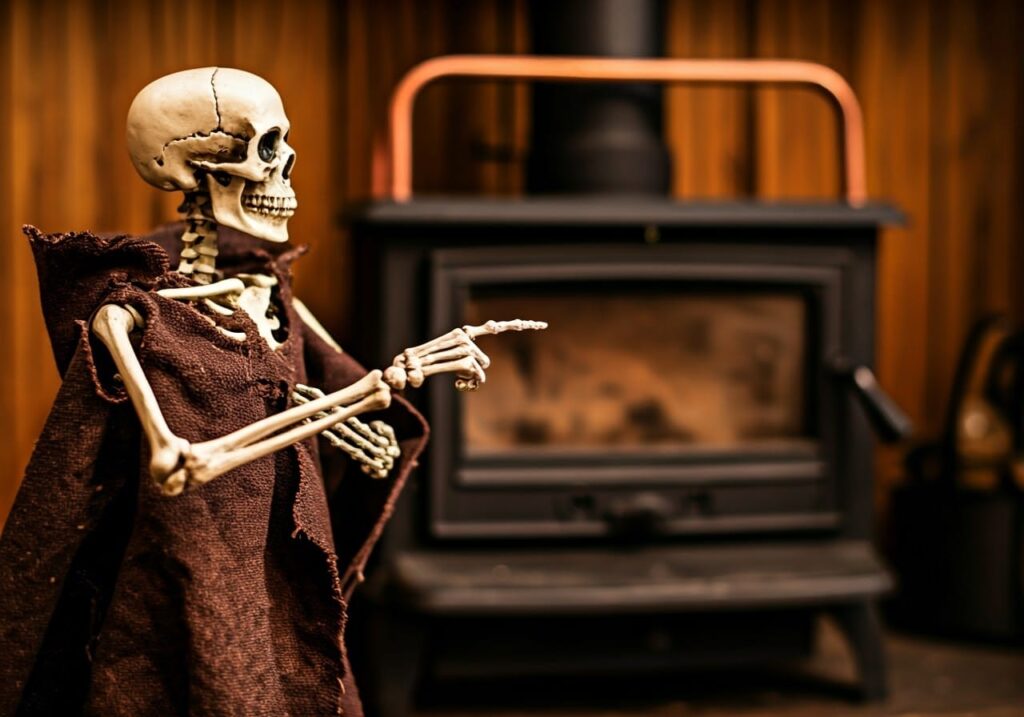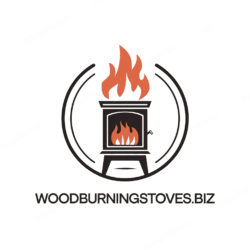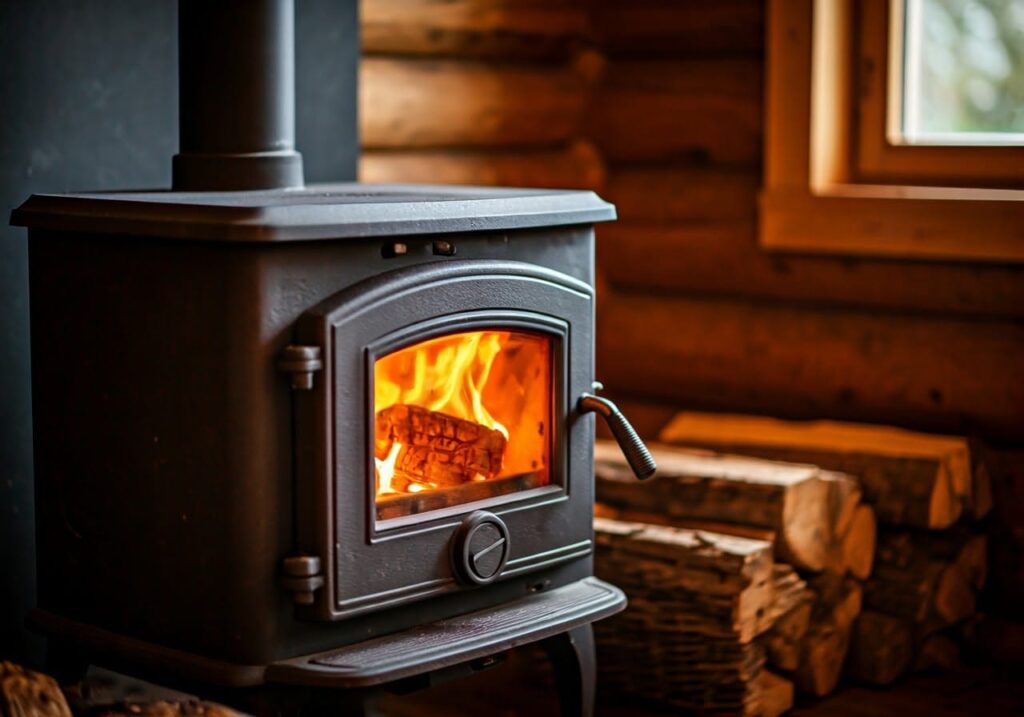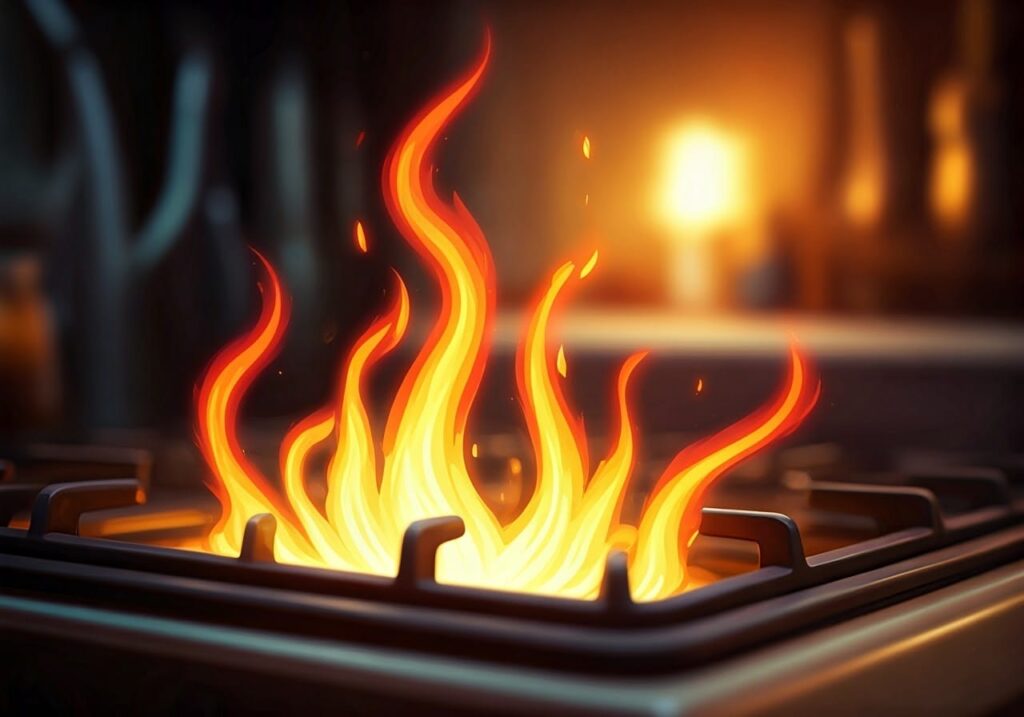For those looking to maximize their wood stove’s performance, understanding its components is essential. While our complete guide to wood-burning stoves provides a comprehensive overview, this detailed breakdown will help you understand each part’s crucial role.

The External Stove Key Components
The Door Assembly
The stove’s door is more complex than it appears:
- Cast iron or steel frame construction
- High-temperature ceramic glass
- Air-tight gaskets
- Heavy-duty hinges
- Cool-touch handle system
The Body Structure
Modern wood stoves feature robust construction:
- Welded steel or cast iron plates
- Double or triple wall construction
- Heat shields
- Decorative elements
- Mounting feet or legs
Air Control Mechanisms
External controls manage combustion:
- Primary air intake lever
- Secondary air controls
- Air wash system controls
- Damper controls
- Draft regulators
Internal Key Components
At the heart of a wood stove lie crucial internal components that facilitate efficient combustion and heat distribution. The Firebox contains the fire, while the Baffle redirects gases for complete burning. The Grate or Andirons support the wood, enhancing airflow. The Heat Exchanger (often in the form of internal Ribs or a Tunnel System) absorbs and radiates heat. Additionally, the Damper and Secondary Air Controls regulate airflow, ensuring optimal burning conditions. These internal components work in harmony to maximize heat output, minimize emissions, and prolong the stove’s lifespan.
The Firebox
As discussed in our main wood stove guide, the firebox is crucial:
- Refractory brick lining
- Steel or cast iron construction
- Ash collection system
- Grate system
- Air inlet ports
The Baffle System
Modern baffles are engineering marvels:
- Stainless steel or ceramic construction
- Multiple channels
- Heat deflection design
- Secondary burn zones
- Replaceable components
Air Distribution System
Complex internal airways include:
- Primary air channels
- Secondary air tubes
- Tertiary air systems
- Pre-heated air chambers
- Air wash channels
Chimney Connection Components
The connection to the chimney is critical for safe and efficient wood stove operation. Key components include the Flue Collar, which attaches to the stove’s rear, and the Adapter or Stove Pipe, connecting the collar to the chimney. The Chimney Snorkel or Telescope Pipe may be used for height adjustments. Sealing Gaskets and Screws ensure airtight connections, preventing leaks and hazards. Additionally, Spark Arresters (in some setups) catch embers before they reach the chimney, reducing fire risk. Proper installation of these chimney connection components is vital for safety, performance, and compliance with regulations.
The Flue Collar
This critical connection point features:
- Standard sizing options
- Heavy-duty construction
- Sealed connections
- Heat-resistant design
- Draft optimization
The Damper System
Damper components control exhaust:
- Flue damper plate
- Operating mechanism
- Position indicators
- Bypass systems
- Safety stops
Safety Features
Modern wood stoves incorporate multiple safety features to minimize risks. The Overheat Shield or Thermal Protection prevents external surfaces from getting too hot. Spark Guards or Spark Screens contain embers, reducing the risk of igniting nearby objects. Tip-Over Switches (in some models) automatically shut off the stove if it’s inadvertently knocked over. Clearances (prescribed distances to combustibles) are ensured via Heat Shields or Clearance Reduction Systems. Moreover, Carbon Monoxide (CO) Detectors and Alarm Systems (often integrated or recommended) alert users to potential CO buildup, providing an additional layer of protection for occupants.
Heat Shields
Protection systems include:
- Rear heat shields
- Side shields
- Bottom heat protection
- Clearance reduction systems
- Thermal barriers
Safety Controls
Built-in safety features:
- Over-fire protection
- Automatic damper controls
- Temperature sensors
- Air control limiters
- Emergency shutdown systems
Efficiency Components
Several key components work in tandem to enhance the efficiency of a wood stove. The Secondary Combustion System re-ignites unburned gases, maximizing fuel utilization. Ceramic Blowers or Centrifugal Fans improve airflow, boosting heat output. Refractory Linings (e.g., ceramic blankets or firebrick) reflect heat, maintain high temperatures, and prolong the stove’s lifespan. Precise Air Controls allow for fine-tuned oxygen intake, optimizing burn efficiency. Additionally, Heat Recovery Systems (such as convection chambers) effectively distribute warmth, ensuring that a higher percentage of the stove’s energy output is utilized for heating, rather than lost.”
Air Wash System
Glass cleaning mechanisms include:
- Pre-heated air channels
- Air distribution manifolds
- Flow control systems
- Glass protection design
- Self-cleaning features
Secondary Burn System
Advanced combustion features:
- Secondary burn tubes
- Catalytic converters (in some models)
- Turbulence creators
- Heat retention channels
- Emission reduction systems
Optional Components
Blower Systems
Fan accessories enhance heating:
- Variable speed controls
- Thermal switches
- Distribution channels
- Quiet operation design
- Easy maintenance access
Ash Management
Ash handling systems include:
- Removable ash pans
- Ash dumps
- Collection systems
- Clean-out doors
- Safety features
Maintenance Access Points
Cleaning Access
Regular maintenance points include:
- Chimney clean-out access
- Baffle removal ports
- Air tube access points
- Gasket replacement channels
- Inspection ports
Replacement Components
Common replacement areas:
- Door gaskets
- Glass panels
- Firebricks
- Air tubes
- Baffle plates
Installation Components
Floor Protection
Safety requirements include:
- Hearth pads
- Thermal protection
- Spark protection
- Extension requirements
- Corner protection
Ventilation Components
Proper airflow requires:
- Fresh air intakes
- Outside air kits
- Vent connections
- Draft enhancers
- Air circulation paths
Understanding Component Interaction
Airflow Patterns
Components work together to:
- Create efficient combustion
- Maintain proper draft
- Distribute heat effectively
- Reduce emissions
- Optimize performance
Heat Transfer Systems
Multiple systems coordinate:
- Radiant heat components
- Convection channels
- Conduction paths
- Heat storage elements
- Distribution methods
Conclusion
Understanding your wood stove’s anatomy helps you operate and maintain it effectively. Each component plays a vital role in the stove’s overall performance and safety. For more detailed information about wood stove operation and maintenance, refer to our comprehensive guide on wood-burning stoves.


